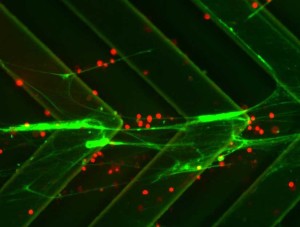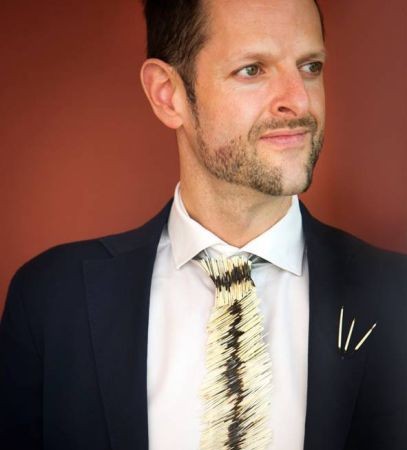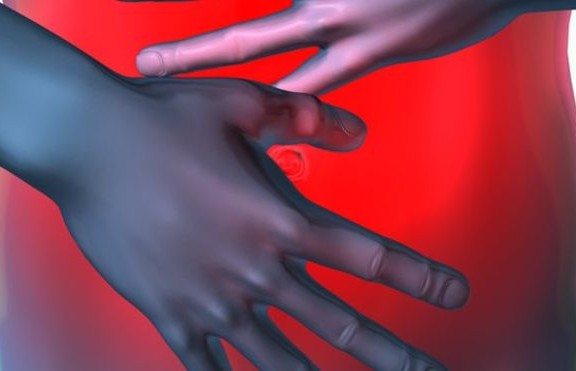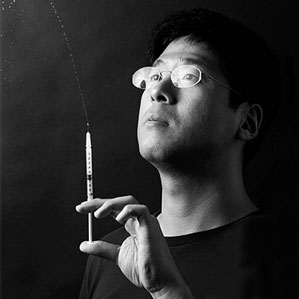Discovery News: Jellyfish-Inspired Tentacles Capture Cancer
Prof Karp’s Interview on Discovery Channel!
January 3, 2013Ben Ouyang Wins Canada’s Got (Science) Talent Sunnybrook Prize!
January 5, 2013Discovery News: Jellyfish-Inspired Tentacles Capture Cancer
Source: Discovery News
Original paper: PNAS – Bioinspired multivalent DNA network for capture and release of cells

A new device inspired by jellyfish tentacles can be used to both count and sort cancer cells, which is an important indicator of how well chemotherapy or other treatments are working.
Source: Rohit Karnik and Suman Bose
Tiny strands of DNA that float like jellyfish tentacles can grab and hold tumor cells in the bloodstream in a device inspired by nature that may help cancer patients fight the dreaded disease.
The device can be used to both count and sort cancer cells, which is an important indicator of how well chemotherapy or other treatments are working. Doctors need to know whether cancer cells are being knocked out or developing immunity.
“The key is to know which drugs the remaining cells would be most susceptible to,” said Jeffrey Karp, an author on the paper published today in the Proceedings of the Natural Academy of Science (PNAS) and co-director of the Center for Regenerative Therapeutics at Brigham and Women’s Hospital in Boston. “Often these cells in the blood stream are at very low concentrations and it’s difficult to isolate them. What you really want to do is collect them and study the biology of the cells and subject them to different kinds of chemo so you know which one is best to use.”
Karp said he’s been stung by jellyfish before while swimming with his son: “It doesn’t do much damage, but it really hurts.” The idea for the microchip came one day in the lab while brainstorming with one of his colleagues.
“We became inspired by jellyfish that have these long tentacles that extend far away from their main body,” Karp told Discovery News. “Regardless where the food lands, they can capture it.”
One end of the strand is connected to the microchip and the other floats free in the bloodstream. As the cancer cells drift by, the aptamers bind to them no matter where they touch, just like a jellyfish grabbing food, Karp explained.
During experiments, Karp and his team were able to capture 60 percent of the cancer cells floating by, a figure higher than an existing method that uses a tiny magnet that binds to the cancer cell and is then picked up by a magnetized micro-sorter.
In other projects, Karp has used the stickiness of gecko feet, the delicateness of spider webs and the spines of a porcupine to come up with new kinds of human medical devices.
“Often in technology we encounter barriers that appear to be insurmountable,” Karp said. “Turning to nature, we can get ideas to think about and help us to think out of the box to new solutions far removed from standard approaches.”
Jeffrey Chalmers, professor of bioengineering at Ohio State University, likes the idea.
“The jellyfish approach is interesting and the initial data looks promising,” said Chalmers, an expert in cell-sorting technologies. “They did a decent job of selling me on it. I like the approach.”
Chalmers said one of the challenges in any kind of cell-sorting is determining the identity of cancer cells. That’s because cancer cells are often hard to distinguish from non-cancerous ones since they are both produced in the body. Karp says the next step is to use the device to check for cancer cells in actual human patients.




2 Comments
[…] http://www.karplab.net/news/discovery-news-jellyfish-inspired-tentacles-capture-cancer.html https://www.livescience.com/32617-how-do-vaccines-work.html […]
[…] “Discovery News: Jellyfish-Inspired Tentacles Capture Cancer.” The Karp Lab, The Karp Lab, 3 Jan. 2013, http://www.karplab.net/news/discovery-news-jellyfish-inspired-tentacles-capture-cancer.html […]